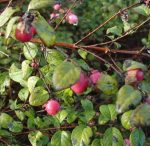 This suckering deciduus shrub is in the honeysuckle family, Caprifoliaceae, that also includes , Abelia, and pincushion flower. It is the result of a cross between S. microphyllus and S. orbiculatus and grows 3-6′ tall with bluish- green, elliptical to broad-ovate leaves that are up to 1.5″ long, and have downy undersides. In summer short terminal racemes of pink to white bell-shaped flowers appear but may be inconspicuous. The flowers give rise to berries that are up to 1/2″ across and are white turning pink to coral on the side exposed to the sun. The berries are attractive to birds and persist into fall or winter. Plants are tolerant of pollution and drought so are a good choice for a border, screen, or hedge in a xeriscape or urban garden. The genus name, Symphoricarpus, comes from the Greek word symphorein meaning bear together, and karpos, meaning fruit and refers to the clusters of berries.
This suckering deciduus shrub is in the honeysuckle family, Caprifoliaceae, that also includes , Abelia, and pincushion flower. It is the result of a cross between S. microphyllus and S. orbiculatus and grows 3-6′ tall with bluish- green, elliptical to broad-ovate leaves that are up to 1.5″ long, and have downy undersides. In summer short terminal racemes of pink to white bell-shaped flowers appear but may be inconspicuous. The flowers give rise to berries that are up to 1/2″ across and are white turning pink to coral on the side exposed to the sun. The berries are attractive to birds and persist into fall or winter. Plants are tolerant of pollution and drought so are a good choice for a border, screen, or hedge in a xeriscape or urban garden. The genus name, Symphoricarpus, comes from the Greek word symphorein meaning bear together, and karpos, meaning fruit and refers to the clusters of berries.
Type: Deciduous shrub
Outstanding Feature:Berries
Form: Upright
Growth Rate: Rapid
Bloom: Short racemes of pink to white flowers in summer
Size: 1.5-2′ H x 6-8′ W
Light: Full sun to partial shade
Soil: Average, medium moist,
Hardiness: Zones 4-7
Care: Rejuvanate by basal pruning in spring.
Pests and Diseases: Generally healthy but susceptible to anthracnose and powdery mildew. scale and aphids.
Propagation: Divide in fall, freenwood cuttings in spring, hardwood cuttings in fall
Outstanding Selections: ‘Handcock’ (dwarf, pink flowers, corl pink berries; useful as groundcover)
Photo Credit: Wikimedia